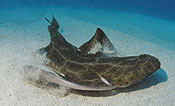This Christmas, Remember the Angels
Not usually famed for their angelic behaviour, sharks are under the spotlight at this week’s EU Fisheries Council meeting.
 Among the sharks in dire need of protection is the Angel Shark – an extraordinary and distinctive fish formerly common off our shores. They are now extremely rare, even extinct in some areas.
Among the sharks in dire need of protection is the Angel Shark – an extraordinary and distinctive fish formerly common off our shores. They are now extremely rare, even extinct in some areas.
The Angel Shark, like many sharks, is a non-quota species and has been hit hard by intense fishing and incidental “bycatch.” Due to its slow growth rate, it has difficulty withstanding heavy fishing pressure.
The result is a species threatened with extinction.
In early 2008, following more than five years of campaigning by the Shark Trust, the UK government finally awarded the Angel Shark protected status in the inshore waters of England and Wales. A solid step, but not nearly enough.
This week in Brussels the European Council of Fisheries Ministers can endorse a European Commission proposal for strict species protection through mandatory release of all Angel Sharks caught by EU vessels.
Ali Hood, Director of Conservation at the Shark Trust, said: “Angel Shark’s flat bodies makes them highly susceptible to trawling which has led to devastating declines in their populations, even regional extinctions. We applaud the UK government for taking the first step in protecting Angel Sharks in English and Welsh waters. We now need the UK to continue this leadership by championing protection for all species of European Angel Sharks throughout all EU waters. Such action is urgently needed to avoid extinction and secure a brighter future for these vulnerable species.”
As an active member of the Shark Alliance, the Shark Trust is promoting additional ground-breaking proposals from the European Commission to protect imperilled Common Skate, Undulate Ray and White Skate and end unsustainable fishing for Critically Endangered Spurdog and Porbeagle Sharks.
It is particularly vital that Europe acts promptly to protect our Angels.
For further information contact:
Ali Hood, Director of Conservation: 07855 386083
Editors notes
- Angel Sharks live on the seabed, nestling into the bottom, waiting for an unsuspecting meal to pass within range of its very powerful and highly protrusible jaws. Although residing on the seabed by day, by night Angel sharks become more active, swimming some distance from the seabed.
- They are particularly large compared to the UK's other fish species, with a broad flat body and a length of up to 180 cm long. It is this flat-bodied shape, and their bottom-dwelling behaviour that makes angel sharks particularly vulnerable to capture by trawlers.
- Angel sharks grow slowly, mature late and give birth to few pups. Female Angel Sharks mature at about 150 cm in length and give birth to 9-20 live young after a gestation period of 10 months. Late maturity and low reproductive rates mean that they are unable to withstand even low levels of exploitation.
- The Angel Shark is categorised as Critically Endangered on the IUCN Redlist. www.redlist.org
- In April 2008 Common Angel Shark were protected under Schedule V of the Wildlife and Countryside Act 1981 making it illegal to injure or knowingly harass Angel Shark in inshore waters of England and Wales.
- The European Commission have proposed a prohibition on the landings of Angel Shark by EU vessels in all EU waters, a decision will be announced by the 19th December 2008.
- The European Council of Fisheries Ministers meet at the December Fisheries Council to negotiate TACs and quotas.
- What are TACs and quotas?Total Allowable Catches (TACs), species quotas and minimum net sizes were first introduced under the Common Fisheries Policy in 1983, in an attempt to curb over-fishing within European waters. TACs are established for each species in a fishery after considering the recommendations of scientists on the size and health of the fish stock. They are usually fixed annually by the EU Council of Ministers, who consider proposals drawn up by the European Commission in consultation with their own scientific advisers, the views of non EU fishing nations and those of the International Council for the Exploration of the Sea (ICES). These TACs are then divided among the countries fishing that stock. A TAC is therefore equal to all quotas combined for that particular fishery. The size of each country’s quota depends not only upon the scientific assessments of available stock, but also their traditional share of the species in question. As the European Community has grown, so has the number of Member States taking a share of the available stocks. Each Member State is responsible for policing its own quotas. It may do so by sharing the country’s quotas between its fishing vessels, or simply by closing the fishery when the quota has been met.
- The Shark Trust is the UK conservation charity dedicated to advancing the worldwide conservation of sharks, skates and rays through science, education, influence and action. www.sharktrust.org
- The Shark Trust is a founder member of the Shark Alliance, a not-for-profit coalition of non-governmental organizations dedicated to restoring and conserving shark populations by improving European fishing policy. www.sharkalliance.org











